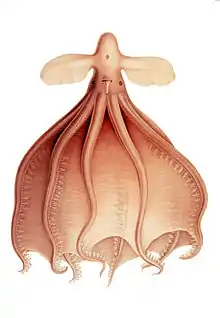Cirrothauma murrayi
Cirrothauma murrayi, commonly called the "blind cirrate octopus,"[2] is a nearly blind octopus whose eyes can sense light, but not form images. It has been found worldwide, usually 1,500 to 4,500 metres (4,900 to 14,800 ft) beneath the ocean's surface.[3][4] Like other cirrates, it has an internal shell, muscular fins for swimming, and a web connecting the arms.[5]
| Cirrothauma murrayi | |
|---|---|
 | |
| Scientific classification | |
| Kingdom: | Animalia |
| Phylum: | Mollusca |
| Class: | Cephalopoda |
| Order: | Octopoda |
| Family: | Cirroteuthidae |
| Genus: | Cirrothauma |
| Species: | C. murrayi |
| Binomial name | |
| Cirrothauma murrayi Chun, 1911 | |
The species was first caught by an expedition led by Sir John Murray in 1910,[6] and it was later named in honor of Murray. It was described by German marine biologist Carl Chun in 1911.[4]
Description
Eye structure
The eye structure is very different from other octopods. Their eyes are small, lens-less and almost non-functional, as the eyes also lack irises and ciliary bodies.[7] The nearly sightless eyes are embedded deep in the gelatinous tissue of their head.[7]
Suckers
Cirrothauma murrayi has about six strong sessile suckers which help them swim as well as hunt fish.[7]
References
- Lyons, G; Allcock, L (2014). "Cirrothauma murrayi". IUCN Red List of Threatened Species. 2014: e.T163011A963624.
- "Cirrothauma murrayi Chun, 1911". World Register of Marine Species. MolluscaBase.
- "Cirrothauma murrayi". tolweb.org. Retrieved 2018-09-14.
- Vecchione, Michael; Young, Richard. "Cirrothauma murrayi". Tree of Life Web Project. Retrieved 12 March 2018.
- Mangold, Katharina; Vecchione, Michael; Young, Richard. "Cirrata". Tree of Life Web Project. Retrieved 12 March 2018.
- Aldred, Nixon & Young 1983, p. 4.
- "Cirrothauma murrayi". tolweb.org. Retrieved 2018-09-14.
Bibliography
- Aldred, R. G.; Nixon, M.; Young, J. Z. (26 April 1983). "Cirrothauma Murrayi Chun, A Finned Octopod". Philosophical Transactions of the Royal Society of London. Series B, Biological Sciences. 301 (1103): 1–54. doi:10.1098/rstb.1983.0021. JSTOR 2396064.CS1 maint: ref=harv (link)
